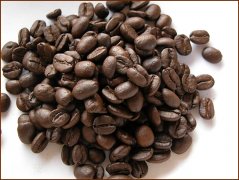Why do some coffee beans have a shiny surface?
Have you ever seen coffee beans that look oily? Why do some coffee beans have a shiny surface, while others are "dry and comfortable" and not greasy? What is the relationship between coffee beans and freshness? Should we buy coffee beans with "oil" or "no oil" appearance?
Coffee oil is not oil.
These "oils" evenly distributed on the surface of coffee beans are not actually "oils", but water-soluble organic substances that look like oils. Coffee oil itself contains a lot of coffee aroma components that dissolve in water, so the surface of your brewed coffee does not float a layer of greasy grease.

2 reasons: oil beans
a stale light baked beans b fresh dark baked beans.
a) stale medium baked beans
The "light roasted beans" with lighter roasting temperature and light brown appearance will be dry after roasting, and will not produce oil. About six days after roasting, the phenomenon of "dot oil" begins to appear (dotted oil droplets appear on one side of the coffee beans). The slight "dot oil" does not mean that it is not fresh, but sometimes the flavor of the light roasted coffee beans is at its peak. Continue to put it down, after more than two weeks, the surface of the light baked beans gradually appears a layer of bright oil, at this time, the flavor of the light baked beans has begun to decline, should avoid buying.
b) Fresh deep-baked beans
Dark baked beans with dark brown appearance appear slightly oily after baking, and a large amount of oil begins to appear on the surface from the second day to the fifth day. The appearance of oily "dark baked beans" does not mean that they are not fresh. On the contrary, the appearance of oily beans will gradually dry out after three weeks, and finally become dry and tasteless beans. Therefore, if you see coffee beans that are dry and not oily, but appear dark brown in appearance, please pay special attention to their roasting date. It is very likely that they have deteriorated.
So choose coffee beans, do not be fooled by "oil light" oh!
Important Notice :
前街咖啡 FrontStreet Coffee has moved to new addredd:
FrontStreet Coffee Address: 315,Donghua East Road,GuangZhou
Tel:020 38364473
- Prev

The average chemical composition of raw coffee beans is as follows
The average chemical composition of raw coffee beans is as follows: water 12%, nitrogen 12%, fat 12%, sugar and dextrin (dextrine) 10%, other non-nitrogen substances 18%, dust 4%, tannin 6.7%, caffeine 1.2%, coffee essential oil 0.1%. Of course, these data are not fixed, and the quantity of some of these ingredients varies greatly, which is why each kind of coffee is so different.
- Next

Picture of deeply roasted coffee beans (Deep Roast)
1. Picture of deeply roasted coffee beans (Deep Roast)
Related
- Guji coffee producing area of Guji, Ethiopia: Humbela, Shakiso, Wulaga
- What is the most expensive variety of Qiloso in BOP multi-variety group?
- How to store the coffee beans bought home?
- Why are Yemeni coffee beans so rare now?
- Ethiopian Sidamo all Red Fruit Sun Sun Santa Vini Coffee beans
- SOE is mostly sour? What does it mean? Is it a single bean? what's the difference between it and Italian blending?
- Is Italian coffee beans suitable for making hand-brewed coffee?
- How to choose coffee beans when making cold coffee? What kind of coffee beans are suitable for making cold coffee?
- Just entered the pit to make coffee, what kind of coffee beans should be chosen?
- Can only Japan buy real Blue Mountain Coffee? What are authentic Jamaican Blue Mountain coffee beans?

